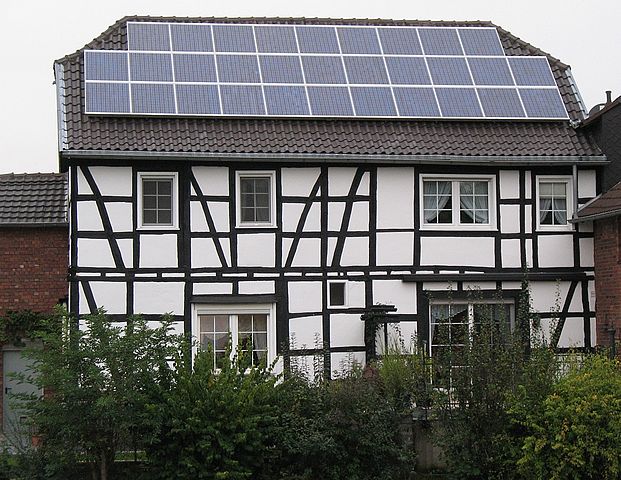 |
OFF THE GRID... |
WHAT MAKES THE SOLAR SYSTEM TICK...
An off-grid system is a stand-alone power plant able to be constructed anywhere the sun shines and where there is a few hundred square feet (30 - 80 square meters) of free land space to mount the system. It can be designed to both fit your electrical needs as well as your budget.
An off-grid system must not be confused with a "feed-in-tariff" or a "net metering" system, whereby solar power is fed into the OPG electrical grid to either supplement purchased OPG electrical consumption or generate power for an OPG tariff received by the client. Both the feed-in-tariff and the net metering system require that an OPG connection exists, as well as not being capable of producing power independent of the electrical grid; with these systems, if the grid is down, then there is no power regardless of the availability of sunshine. An off-grid system is atonomous; it is stand-alone, has no connection other than the one bringing power to your house, and is capable of storing power for night time and cloudy conditions.
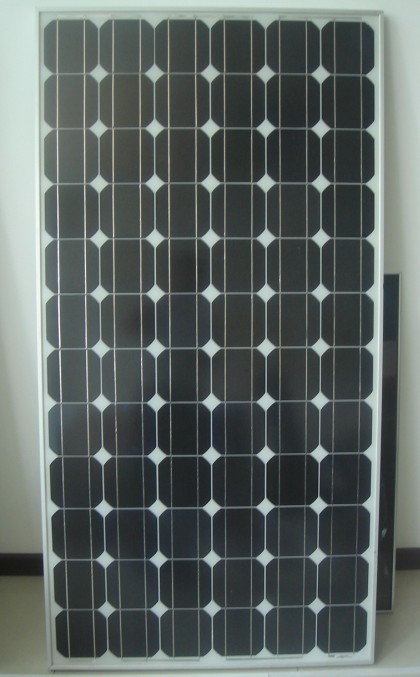 |
The solar panelsThe solar panels are mounted to face the sun, producing electricity from the energy of sunlight. Their main function is to charge the battery bank. They come in 50, 100, 130, 185 and 250 watt sizes typically. They can be mounted to face South permanently, or on a rack which you can turn to face the sun during various times of the day. Life expectancy = 50 years |
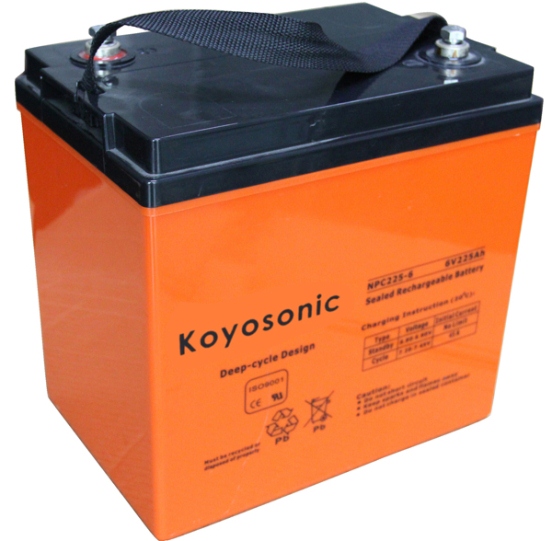 |
The battery storage bankThe lead-acid 6V deep cycle battery is the hardiest and most economical solution for storing your solar energy. The battery bank is formed to size using a method of series-parallel interconnection allowing for the correct voltage and current capacity to be attained. Each battery stores about 1.2 Kilowatt hours of power. Although lithium ion and nickel-cadmium batteries are available, the lead-acid deep cycle battery is most practical in the Canadian climate. Life expectancy = 8 - 10 years |
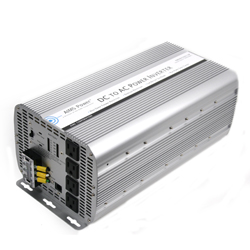 |
Power inverterThe power inverter converts the low-voltage, high-current direct current of the battery bank into 117 VAC or 117-234 VAC household current. The power is then sent to the house via a cable and input receptacle attached to your house. This receptacle can be self-connected to the circuit breaker box of the home or it can be connected by an electrician. The receptacle is similar to that used for an auxiliary generator option. Life expectancy = 25 years |
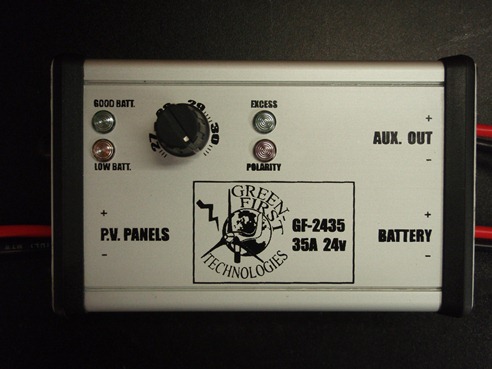 |
Charge controllersGf-series charge controllers manufactured by Green-First regulate the battery voltage to its optimal level. A number of cables are also necessary to
|
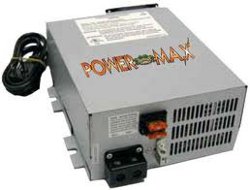 |
Battery chargerThe smart charger may be used in pairs for the larger systems. The charger converts the output of the backup generator to the low-voltage DC current required to recharge the batteries. Life expectancy = 25+ years |
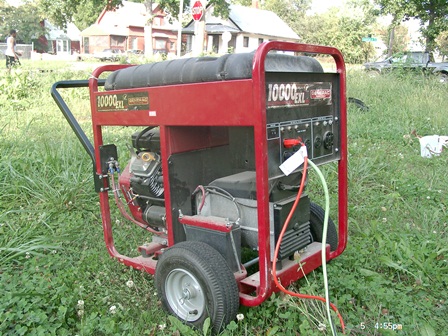 |
Backup generatorThe generator can be either gasoline or diesel-fired, manual or automatically starting on demand. Life expectancy = 25 years |
What else you will need...
1: A rack to mount the panels
The solar panels can be mounted on the roof of your home, the roof of a garage or out-building, or on a rack fixed to the ground. The various mounting styles have their advantages and disadvantages.
Roof-mounted panels cannot always be angled properly to face the sun at their optimal direction, cannot be cleaned from snow, and may increase your home insurance cost; yet will offer a safe place from vandalism and theft and possibly avoid shading from nearby obstacles due to their added height.
Mounting panels on the roof of an out-building or garage adds to the convenience of having a compact system wherein the storage batteries are housed in the same building, and generally home insurance is not affected through this mounting method. Yet, the challenges of facing the sun correctly and cleaning the panels still exist.
Ground mounted panels allow for easy cleaning, the option of rotating the panels to track the sun which may increase your daily power production by 50%; however, the panels are more vulnerable to theft and vandalism as well as the system uses more land area. If land area is available, this is the preferred method of panel mounting.
2: Battery storage shed
A small shed of about 8 feet X 8 feed, or a corner of a garage or existing out-building, is ideal for storing the battery bank as well as all the other components of the power system. As the batteries give off an odor, it is not recommended they be stored in the home.
3: An auxiliary generator connection
A receptacle mounted on the outside wall of your home, wired into the main circuit breaker box serves to connect the power system to your home. This receptacle is a 40-amp or equivalent 3-wire connector normally used to connect an auxiliary generator in case of OPG grid failure. It is commonly purchased at a hardware store, and can be either self-installed or installed by an electrician. The output of the solar power systemis directly connected to this receptacle via a cable.
SOLAR SYSTEM PACKAGES AND APPROXIMATE COST
Below are listed a number of popular solar system packages, including details of major components and the approximate price range. An exact price is not possible at this point due to the fluctuating international markets, however, the cost will remain within the prescribed range unless an additional challenge is encountered not normally present in a solar installation (for example, a long distance of cabling between home and panels or battery storage shed). The systems listed are only examples; they can be taylored to your requirements and budget.
500 WATT SOLAR SYSTEM
This system is small, but powerful just the same. Producing about 75 Kilowatt-hours per month average, it is capable of producing 5 Kilowatt-hours on a bright, sunny day. It is capable of running computer systems, lights, smaller flat-screen televisions,occasionally a microwave oven, medium capacity power tools, and two slices of toast at a time on a bright sunny day. It is a good choice for a small cottage or a log cabin where economy is the key while maintaining access to continuous electricity.
- 500 watts solar panels
- 8 deep-cycle 1.2KW-H batteries = 9.6 KW-hr total storage
- GF1235 charge controller, cables, fuses and switches
- 2500 continuous output full sine inverter
- 30 ampere smart charger
- Customer training for system useage and maintenance
- Installation, 5-year warrantee and maintenance plan
- $5900.00 (backup generator = $1300 extra)
1 KW (1000 WATT) SOLAR SYSTEM
The 1 KW system allows for all of what the 500 W system can do, but you can also make your own coffee with an electric coffee maker, watch large-screen TV for a few hours at a time, run a small bar fridge. Ideal for a cottage with a family, it can also serve well for a family household ready to make solar work through conservation and sun-time management. Able to deliver up to 10 Kilowatt hours on a sunny day, this system produces approximately 150 KW-hrs a month, well over $110.00 per month on present OPG charges.
- 1000 watts solar panels
- 12 deep-cycle 1.2KW-H batteries = 14.4 KW-hr total storage
- 2 X GF2435 charge controllers, cables, fuses and switches
- 3000 continuous output full sine inverter
- 30 ampere smart charger
- Customer training for system useage and maintenance
- Installation, 5-year warrantee and maintenance plan
- $8700.00 (backup generator = $1300 extra)
2 KW (2000 Watt) SOLAR SYSTEM
The 2 KW system is powerful and capable of operating a household with ease. Power production is up to 20 KW-hrs on a full sunny day, with an average projected power output of 300 KW-hrs per month. Capable of providing the same service as the 1KW system, this one allows for operating a washing machine, electric water-well pump, 2 - 4 computers simultaneously while still running other household appliances. It is a good choice for the family who is serious about getting off the grid and still intends to adjust to sun schedules and make provisions for seasonal changes. The power from the 2KW of solar panels together with the large battery bank allows for a good return of power even on semi-cloudy days.
- 2000 watts solar panels
- 20 deep-cycle 1.2KW-H batteries = 24 KW-hr total storage
- 3 X 2435 charge controllers, cables, fuses and switches
- 3000-4000 continuous output full sine inverter
- 2 X 30 ampere smart chargers
- Customer training for system useage and maintenance
- Installation, 5-year warrantee and maintenance plan
- $16,200.00 (backup generator = $1300 extra)
3.2 KW (3200 Watt) SUPER SOLAR SYSTEM
The 3.2 KW solar system has a great capacity for powering a home and workshop. Producing up to 32 KW-hrs on a sunny day, the power output is approximately 500 KW-hrs per month. Its unique 220 VAC inverter allows for multiple appliances to be run, while being able to power heavy shop equipment on demand. For a family interested in a lifetime of solar power, this system is the ultimate choice.
- 3200 watts solar panels
- 32 deep-cycle 1.2KW-H batteries = 38 KW-hr total storage
- 3 X 2435 charge controllers, cables, fuses and switches
- 6000w continuous, 18000W surge output full sine 220 VAC inverter
- 2 X 40 ampere smart chargers
- Customer training for system useage and maintenance
- Installation, 5-year warrantee and maintenance plan
- $21,800.00 (backup generator = $1300 extra)
YOU CAN IMPROVE THE SYSTEM WHEN NEEDED
If you decide to improve or expand your system in the future, it is easily done without having to start from the beginning. Some components, such as the power inverter and charger components, may have to be replaced, and Green-First will give you a competitive trade-in price on your used items to discount the system expansion.
WE TRAIN YOU ON HOW TO USE YOUR SYSTEM...
Learning how your system works and how to take care of it is important for you. We will work together with you so you understand how every component works, how to take care of it, and how to look for any signs of trouble. Yes, we already award a full 5 - year warrantee on our installations, as well as a 5 - year extendable maintenance plan from the time of installation. It is beneficial, however, for you to know how everything is supposed to work. We invite you to assist in the installation of the system. If you have a family, such as young learners who you feel should know about green energy and how the solar system works, we will invite the young learners to participate in a solar system teaching session with hands-on experience.
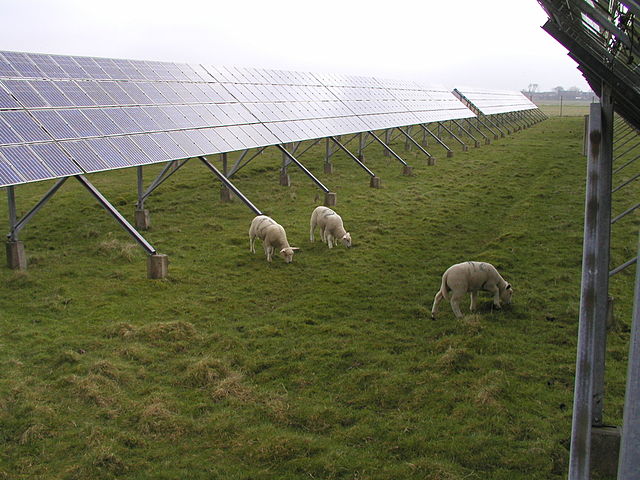
Contact us at info@green-first.com for questions about off-grid systems or to place an order